15 Unexpected Animals That Can Kill You Quickly
We all know that nature has the potential to kill. There is a reason our
deeply seated phobia of spiders and snakes exists, and it isn’t
just for culturally significant reasons. Nature may be pleasant to the soul and
wholesome to the body, but its creative force is equally balanced with
destruction. Deadly venom can break down our blood, paralyze our limbs, and shut
down our organs. Thorns, barbs and teeth pierce and rip our flesh wide open. In the
wilderness, we are only as secure as the quality of our technological advances
in clothing, shelter, transportation, and communication. Even in our own homes,
we are still vulnerable to disease carrying vermin, poisonous insects and
lizards, and even the occasional rabid bat or raccoon.

But humans can adapt, and we can also learn. So, our survival has grown up
around spotting dangers ahead of time, and finding ways to combat them. We’ve
gotten familiar with the obvious precautions like don’t swim with sharks, don’t tease grizzly bears, and
don’t climb in cages with tigers.
What if we move from the well-known, to the lesser known? What if
ferocity and risk were coming from an animal who didn’t have a reputation as
something deadly, and because of our ignorance we do not spot the threat until
it is way too late? At the risk of inducing unimagined nightmares and widespread
paranoia, let’s explore 15 such creatures with hidden capabilities for homicide.
15) Pfeffer’s Flamboyant Cuttlefish
This species of cuttlefish is found in many Indo-Pacific waters, including
off the coast in Australia and the Philippines. These cuttlefish produce sepia
ink like a squid, and hunt for prey in a similar way to that class of creatures.
It is often found walking along the sea floor on its fleshy papillae, and is a
highly prized specimen for ocean photographers and videographers. Its
vibrant coloring, numerous fascinating protuberances, and ruffled adornments
growing off its large, protective mantle make for a great subject for
photographing. Chromatophores, leucophores and
iridophores are all structures you can find in the fish’s skin, containing bright
pigments that allow the animal vivid and highly varied color changing
capabilities beyond simply blending into the scenery like other cuttlefish.
Pfeffer's Flamboyant Cuttlefish
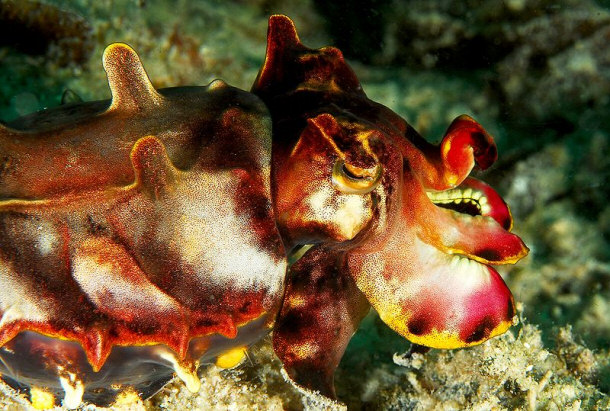
By Jenny (JennyHuang) from Taipei (Flickr) [CC-BY-2.0],
via Wikimedia Commons
But in nature, we know bright colors exist for a reason: usually as a
warning. All cuttlefish can be deadly hunters to their usual prey, going so far
as to use the same nervous system controls that allow them voluntary color
changes to hypnotize their victims into stillness. Pfeffer’s cuttlefish,
however, also is one of the few cephalopod species to carry poison as well. This
cuttlefish’s neurotoxin at least results in nausea, but can also cause
paralysis, respiratory arrest, and heart failure.
14) Humboldt Squid
While squid large enough to take down whaling ships are the stuff of
cryptozoologists’ daydreams, there are some very large—and very deadly—squid
that might be looming closer than you think. The less-than-humble Humboldt is
one of them. Found right where the water goes deep along the Eastern Pacific
shore, these squid have a mantle alone that can reach up to just under 5 feet,
and travel in groups called “shoals” that can have as many as 1,200 individuals.
While their reputation for aggression towards humans is disputed, they are
voracious and opportunistic feeders that will even resort to cannibalism on
injured shoal members to fuel their rapid growth.
Humboldt Squid - Giant Squid
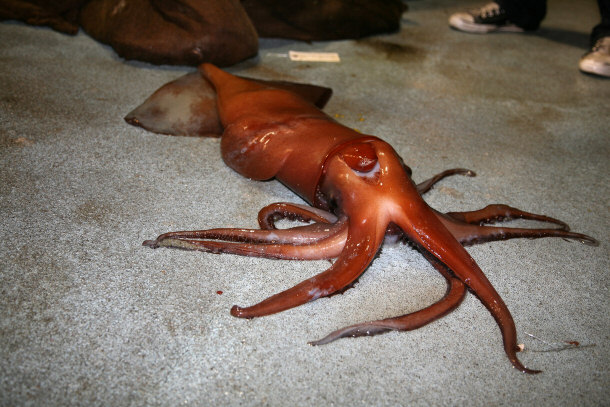
The Humboldt’s razor-sharp beak can bite through both flesh and even bone.
Additionally, their tentacles are covered in not just regular suckers, but barbs
that can snag and skewer prey as they wrap around it. Researchers have watched
their territories spread north into Alaska, meaning an increasing number of
chances for interaction with humans, too. Interestingly, the Humboldt is also
one variety of squid commonly commercially fished in Mexico and Peru to serve
numerous markets—European and Asian, predominantly. This means if you stick to
the land, you have a better chance of eating a Humboldt before it attempts
eating you.
13) Swans
Swans appear often in folktales as beautiful princesses in disguise. They
inspire poets, artists, and cultural lore as symbols of true love, fidelity, and
breath-taking beauty. But snow-white feathers and stable monogamous
relationships—which, incidentally, are found in 80% of all bird species—aren’t
the only qualities these graceful beauties are hiding. The recent film Black
Swan might be a more accurate description of this bird’s demeanor, a far cry
from the more popular ballet motif of Swan Lake.
Black Swan Among White Swans
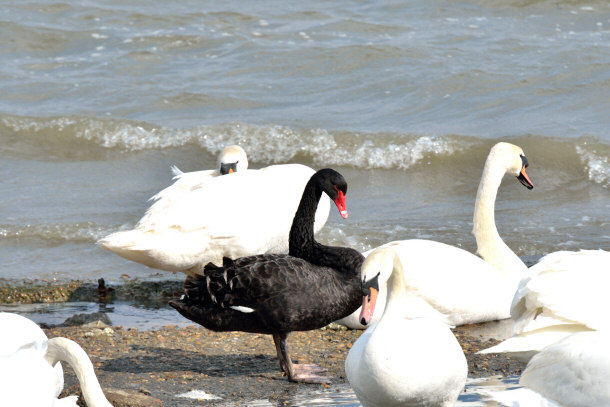
Swans are malevolent, jealous, and aggressive. Some Irish rowing teams full
of strapping young athletes in their prime have canceled practice on occasion
due to swans in their river. Swans have run off waterfowl to find nesting
ground, and they attack fiercely not just to defend their young, but when
generally annoyed. At 60 inches long, 33 pounds in weight, and having a wingspan
of 3 feet, these are the largest specimens of the family Anatidae, which
includes swans, ducks, and also geese. Speedy on land, they have noisily bullied
and chased off multitudes of predators, as well as interested humans. Their
strong beak gives them quite a grip when they bite down and hold. As painful as
this might be by itself, it gets deadlier in the water. Their favorite mode of
attack is to swoop down on their targets, grab them, and drag them under to
drown them. Not a very graceful way to leave this planet.
12) Hooded Pitohui
The bright golden-orange plumage of this New Guinean songbird marks it as
part of the family Oriolidae, or the old world orioles. Unlike most of our
feathered friends, this one is the first documented case of a venomous bird.
Locals still eat the species after rubbing the meat in charcoal to ward off the
effects, and researchers first discovered this poisonous passerine’s nature
after suffering only irritation after handling or being scratched by the bird.
Those with open wounds or longer exposure seemed to suffer more intense pain and
temporary limb paralysis.
Hooded Pitohui
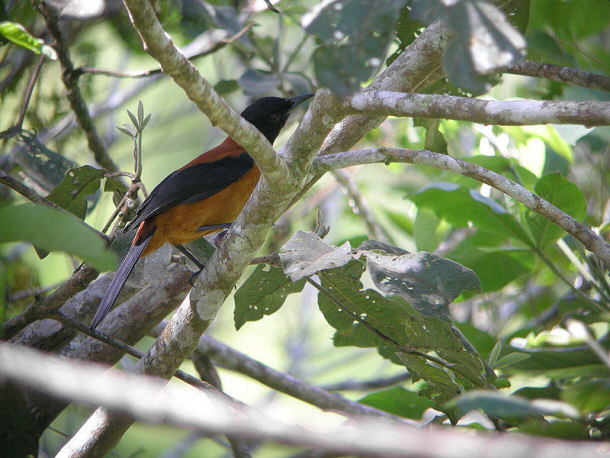
By markaharper1 (Hooded Pitohui) [CC-BY-SA-2.0],
via Wikimedia Commons
Something you might consider though, is that the pitohui utilizes the
neurotoxin homobatrachotoxin in its skin and feathers, which is the same poison
found in the infamous poison dart frogs. Normally, the bird only uses this venom
to avoid predation. However, a laboratory injection of this toxin instantly killed a
mouse, and has been measured as the most deadly toxin known to humankind. In low
doses it causes numbness and tingling, and at greater amounts paralysis and
death from the interruption of neurological electrical currents—possibly sodium
gated channels. The typical amount of venom in a solitary bird leaves the latter
result largely up to chance, and to the system of the person in contact with it.
Like other small venomous animals, the greatest risk is the first absorption of
toxin causing strong shock, leaving the body unable to metabolize the poison and
overcome its effects.
11) Bullet Ant
Some indigenous tribes in South America use the bullet ant in an initiation
ritual, where young men wear special woven gloves over their hands with these
ants trapped stinger first. Participants must endure 10 minutes of torture by
these angered animals coming out of a drugged stupor laid on by the medicine
man. Keep in mind, though, this ritual is centuries old and carefully
administered to cause pain and only temporary injury, under watchful eyes ready
to speed relief if things turn to dark. Let to their own devices in the
rainforest, these ants can do much worse. These inch long creatures take their
name from the fact even one sting is so painful, it feels like getting shot.
They nest in trees, and defend their hives fiercely, shrieking—yes, shrieking—as
they leap out or drop down on unsuspecting passers-by in the jungle who
mistakenly wander too close.
Bullet Ant - An Insect Bite as Powerful as Taking a Bullet
From A Gun
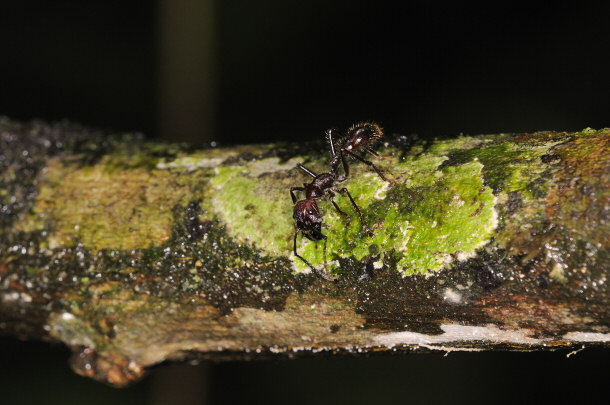
A handful of these insects injecting their neurotoxin will cause a mostly
localized effect within minutes, but a colony of these ants attacking can cause
whole body paralysis, respiratory and cardiac arrest within seconds. Even a
nonfatal attack can turn achingly swollen flesh black, can last 24 hours, and in
some cases, leave chronic, lingering pain for months.
10) Moose
Moose may appear to be gentle herbivores, with no threat to humans outside of
a Monty Python Easter egg at the beginning of the Holy Grail. Most of the time,
it’s true these giants remain docile and nonaggressive—particularly towards
humans in their various habitats across the northern areas of the Northern
hemisphere. They even lack upper teeth, relying on a few sharp incisors below
and their tough tongue to process the woody plants they live off of. However,
with adult bull moose measuring in at up to 7 feet at the shoulder and weighing
up to 1500 pounds, an injured or frightened animal can turn into a deadly deer
very quickly.
Moose Feeding in the Wild
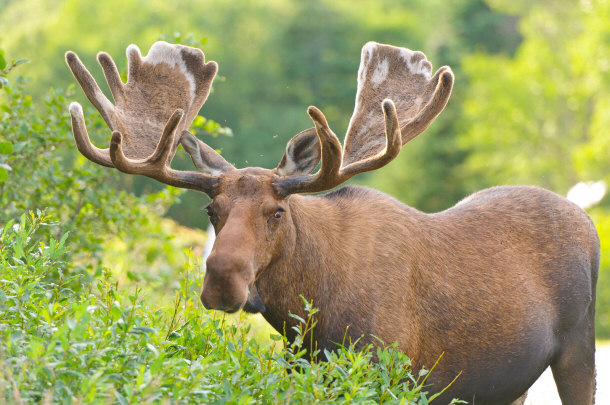
Some varieties of moose have sharp prongs on their palmate antlers. Like most
deer, they are skilled at using their antlers to charge and pin opponents. But
it is really a moose’s size that is its weapon. Moose are adept at thwarting
their predators, often simply stomping wolves into submission—sometimes inducing
fatal injury—and even fighting off bears. Except for killer whales who attack
strategically from the shoreline, Siberian tigers, and some brown bears, most
animals who prey on moose only do so in the form of carrion, or they pick off
calves and already weakened animals. Keep in mind that in America, moose injure
more people than any wild animal, and would hold that record worldwide if not
for the hippopotamus. The high hormones of mating season, and maternal
attachment to calves contribute seasonal attacks on both visitors to the
woodlands, as well as long time residents. While most of these injures are not
fatal, you’re playing with a law of averages here. Do you really want to be the
one that bucks the trend to become a statistic and juicy cautionary tale?
9) Giant Anteater
Due to rampant habitat destruction and poaching, the giant anteater is listed
as “vulnerable” by the International Union for Conservation of Nature. This
terrestrial relative of sloths has a reputation as a docile insectivore, and it
is a favorite fascination of children the world over. With its poor eyesight,
fuzzy pelt, and lack of teeth, this Central and South American resident can tug
at our heart strings. Don’t be fooled by its cuddly appearance and quiet
life eating termites and ants, though. These animals grow to be between five and
seven feet long, and weigh up to 100 pounds. They are also fantastic swimmers,
and seen by some indigenous peoples of the Amazon Basin as a trickster god. The Kayapo even consider them a worthy rival to the jaguar.
Giant Anteater - Myrmecophaga tridactyla
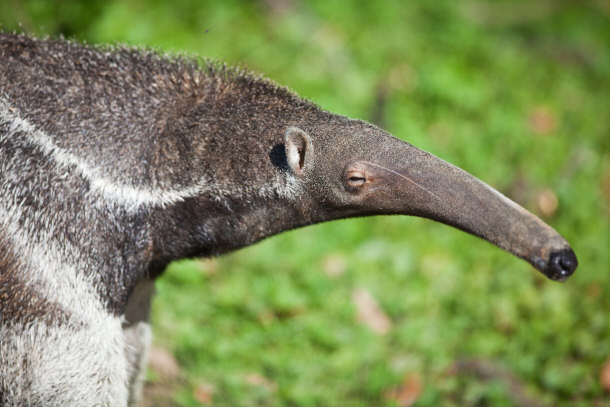
Salvador Dali has even hyperbolized their size, demeanor, and power to make
them seem “terrifying,” but you might be wondering what about these animals may
have captured the dark side of so many imaginations. If so, check out a giant
anteater’s front paws. Giant anteaters have massive claws that generally stay
tucked under while walking. These claws are mainly used for digging, mating
competition, and, oh yeah, defending itself. Giant anteaters are not only
capable of mauling a grown human with their slashes, but can potentially
disembowel you with a single, well-placed strike. Maybe we would be better off
calling them by another of their names: “antbear.”
8) Sloth Bear
Although, calling this one a bear doesn’t seem to help much. Native to the
Indian subcontinent, these animals are even more feared than tigers,
despite—like the giant anteater—subsisting on a diet of small colony insects
such as termites and ants. Why, you might ask? Because the roughly 3 foot high,
300 pound bear has a nasty set of teeth, as well as a 4 inch wide paw pad
covered in razor claws. It mauls at least one person a week in India, with a
signature opening move of ripping the victim’s face off.
Sloth Bear
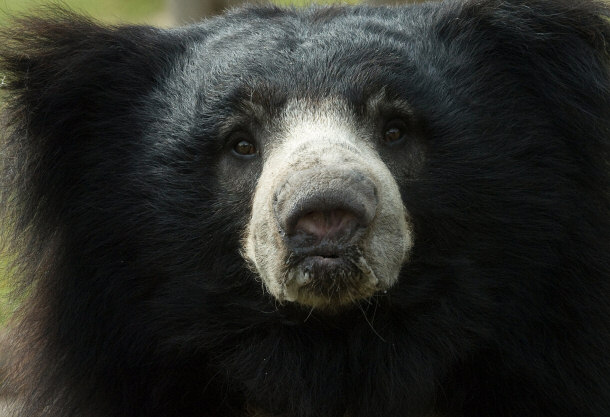
Although appearing slow, with clumsy movements, the bears can be agile tree
climbers and swifter runners that can easily out pace humans. Though some Bengal
tigers have made a habit of preying on these and sun bears, the those notorious
predators actually give the bears a wide berth. Perhaps we should, too.
7) African Hunting Dogs
Scared of lions? These wild dogs have an 80% successful hunting rate over a
lion’s 10%, and a pack can strip a gazelle’s body in minutes. The feline
predators of the savannahs often get the most coverage, but these 40 to 80 pound
canines are no slouches. 30 inches tall from the shoulder and 42 to 74 inches
from tip of snout to tail, only the grey wolf can beat them out for size and
power.
African Hunting Dogs - Selous National Park, Tanzania
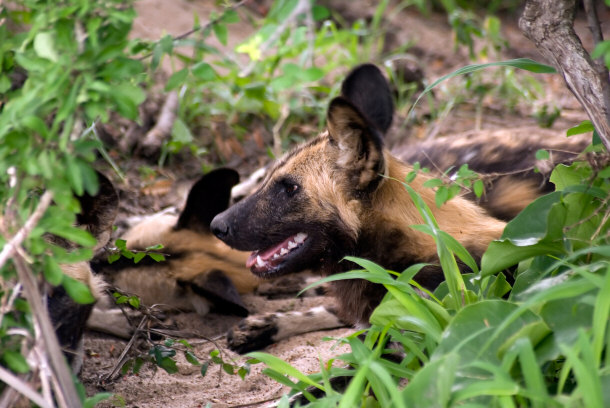
The painted dog--as it is also known--can run up to 35 miles an hour, and
prefers to run down prey in an open chase. Most of them feed off antelopes and
gazelle, with the occasional wildebeest calf. When available, some packs even
hunt ostriches. Researchers found larger packs hunt game as large as zebra, and
their dentition is much like a hyena’s in that it allows them to eat massive
quantities of bone. Like many potentially deadly animals, hunting dogs are
opportunistic eaters that are able to adapt quickly and take in a varied diet.
Unfortunately, this makes them a lot less shy about taking a bite out of us.
6) Stingray
For the most part, these cousins to sharks really are tranquil creatures that
would much rather glide away from danger in the shallow waters they inhabit.
Areas like the Cayman Islands offer tourist attractions allowing swimmers and
divers to spend time in close contact with these animals, and zoos often include
exhibits that allow young and old alike to pet one of the creatures. In fact,
you are probably more likely to die driving one of the cars bearing the same
name, as you are by this creature’s hand—or tail, rather. The “sting” in
stingray exists for a reason, though, and all species of stingray have one or
more venomous barbs in said tails. Fired only in self-defense, generally this
barbs only cause pain at the site, and the worst of the experience is they break
off, needing to be surgically removed. However, depending on the location stung,
things can be much worse.
Darkspotted Stingray - Himantura uarnak
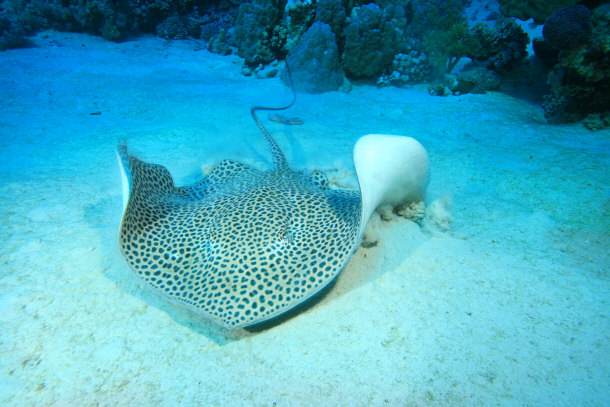
The most infamous case occurred in 2006, when naturalist Steve Irwin received
a sting to the chest that is thought to have gone between his ribs and into his
heart. Still, this has caused only a temporary lull in the stingray’s
popularity, and you can be sure Irwin himself would be pleased to know the
public’s fascination with the placid poisoner has not waned.
5) Cone Snail
These are the bane of shell-collectors and beach combers everywhere.
Indigenous to Indo-Pacific reefs, these creatures are highly coveted for their
shells and highly feared for the toxin they carry. Predatory in nature, these
snails survive by injecting fish who swim too close with a vicious cocktail of
various neurotoxins that cause instant paralysis. The trouble, of course, is
that they don’t distinguish between dinner and a diver. The harpoon like barb
they attack with is extremely sharp, and once the flesh of their target is
pierced, these animals contain an anatomical system that allows them to control
a spurt of venom from their venom bulb out through the harpoon like a
high-pressure pipette.
A Textile Cone Snail
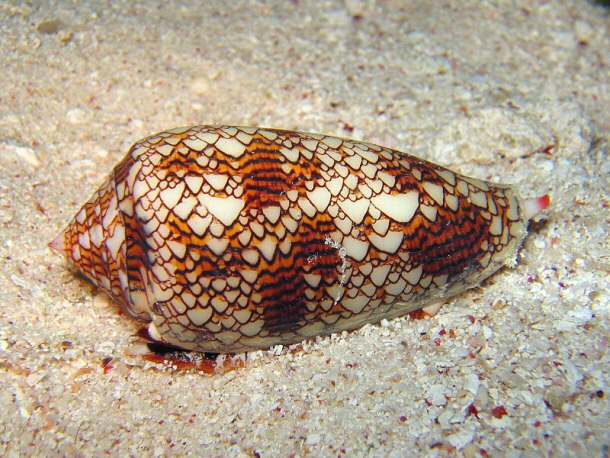
By Richard Ling (Location: Cod Hole, Great
Barrier Reef, Australia),
via Wikimedia Commons
There is no cure for cone snail venom. Divers with observant team members
have a chance of making it to land, but even then, recovery depends on your
system and available medical care to manage your symptoms until the toxin breaks
down and passes. Depending the species of snail, managing to not experience
total shutdown wins you hours involved with a random lottery of symptoms that
may include: tingling, neuropathy, paralysis, possible cardiac arrest, nausea,
hypersalivation, and diarrhea.
4) Blue-Ringed Octopus
Topping out at 8 inches in span and often found with only golf-ball sized
bodies, the blue ringed octopus seems to be yet another adorable, harmless
member of land-locked tide pools left over when the surf slides back out to sea.
It’s even very pretty, with the electric blue rings that glow all over its body
when it feels threatened. However, these widespread inhabitants of the Pacific
shorelines are the most venomous marine animals to date. Their population is
centered in Australia—home to a multitude of deadly creatures—and they boast a
powerful neurotoxin that is produced by bacteria living in their air sacs.
Blue-Ringed Octopus in Lembeh Straits, Sulawesi, Indonesia
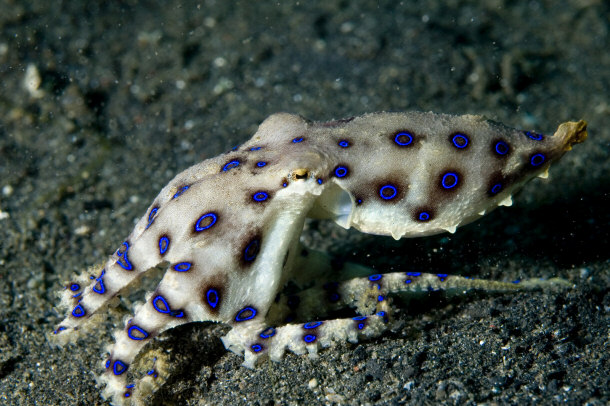
Their beaks are powerful enough to break through wetsuits, and the venom they
release 10,000 times more potent than cyanide. By interrupting sodium channels
in the nerves, the fast-acting poison causes quick paralysis, With no anti-venom
available, the only way to survive is by alert companions who can administer
rescue breathing until you can be placed on a ventilator. If you manage not to
die, recovery is a definitely possibility, as the toxin will break down if the
body is able to keep metabolizing it. Still, best not to play any game you can’t afford to lose.
3) Bottlenose Dolphin
The most common dolphin species, bottlenose dolphins are known for their
intelligence, playfulness, and friendliness towards humans. Their curiosity is
strong, and there are tales of them rescuing drowning swimmers and shipwreck
victims, which lets us attribute a primitive empathy to them. But it might be
all in our heads, as these same creatures are also known for their rampant
sexual appetites, jealousy, and cruel mischief.
Three Bottlenose Dolphins - Tursiops truncatus -Leaping in
Formation

Male dolphins sometimes become aggressive around male handlers when a female
is present—either dolphin or human. Pods of dolphins have been known to kill a
porpoise and then play with the corpse for no apparent reason other than
entertainment. Dolphins can swim up to 21 miles per hour, allowing them to wear
out and overcome their victims. Their mouth is full of sharp, conical teeth that
can easily grip and tear apart the flesh of many other marine mammals. Think
what that could do to us. Researchers found dolphins can even use their
echolocation to locate the vital organs in some animals. They are adept at
pummeling animals with their muscular tails, with enough force to liquefy organs
and break bones. Keep this in mind the next time Flipper smiles at you.
2) Hippopotamus
These plump, round animals have all the proportions necessary for cuteness,
and have delighted zoo patrons for generations. You may think all they do is
placidly swim and graze all day but their bulk isn’t just fat from an indolent
lifestyle. These vicious water horses are muscular warriors with a power that was
even revered by the ancient Egyptians as godlike. On land, they aren’t
territorial, but when threatened, will charge and give chase for quite a long
way. They can run up to 35 miles per hour in a charge.
Hippopotamus Showing Teeth
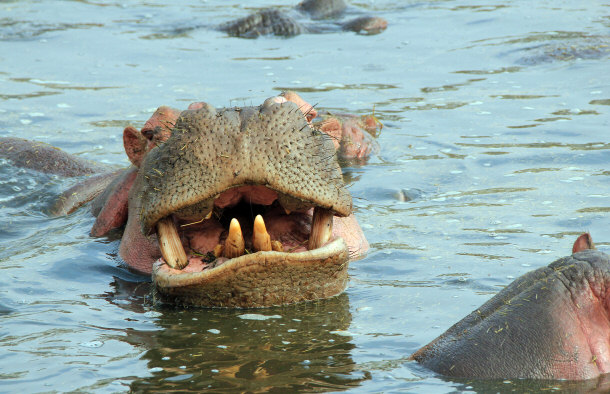
In the water they move slower over a distance, but they are acrobatic when
they want to be. Adult bull hippos are prone to fighting, and all hippos are
naturally aggressive. Their teeth are made for grinding grasses, but their jaws
are extremely powerful. As the third heaviest land mammal, the 7,100 pounds
older males often weigh up to gives them the advantage of weight. This advantage
can be used to crush a
threat, utilizing biting, stomping or stampeding, and rolling when in water.
These animals definitely bestow the wisdom that caution is a very important survival skill.
1) Chimpanzee
Known for their cuteness and their genetic and developmental closeness to
humans, these cousins of ours are often considered childlike and playful,
stirring up controversy over their role as important research subjects in
language, memory, early development, and medical trials. Hollywood has been
fascinated with them for decades, giving them starring roles as sidekicks to
jungle heroes and comic relief in numerous kids’ movies. Among the wealthy,
keeping them as exotic pets is still a trend, the heart-warming appearance and
behavior of baby chimps overcome their more sinister side.
Two Chimpanzees Socializing
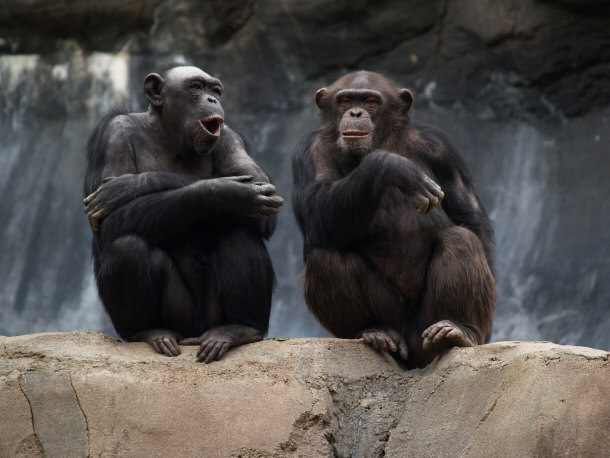
Full-grown chimps are not cuddly, nor affectionate—instead they are
aggressive and predatory, even fashioning rudimentary weapons with their
tool-making gifts and going to war with other chimpanzees in the wild. Bare
handed combat is their specialty, and being 30 times stronger than an
adult human they are far from our equals as far as physical strength and agility
goes. They are far more superior at hand to hand combat than any human being
could be. They can break
bones and smash skulls, and have been known to rip faces off with blinding
speed. Additionally, according to Pan African News, in 2002, a 14 month old baby
was stolen and eaten by an adult male chimpanzee before the child could be
rescued. It can’t be stressed enough that chimpanzees are fast with their
strength, and fear very little—especially from us, when they began to see us as
sources of food and entertainment.
Conclusion
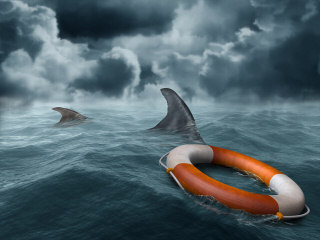 There is no single theme here that defines what makes an
unexpectedly deadly creature. However, there are patterns. Neurotoxins are
certainly something to watch for, avoid anything that stings, and don’t provoke
large, wild animals. Maybe try staying out of Australian reefs altogether—we all know
there’s a lot of unexpectedly deadly animals there. There is no single theme here that defines what makes an
unexpectedly deadly creature. However, there are patterns. Neurotoxins are
certainly something to watch for, avoid anything that stings, and don’t provoke
large, wild animals. Maybe try staying out of Australian reefs altogether—we all know
there’s a lot of unexpectedly deadly animals there.
Whether on dry land, wandering waterways, lounging on the beach, or diving
into the depths of the ocean, a close examination of nature reveals you never
are quite as secure as you think. Poetically morbid as it might be to state it, death is a companion that walks close to us at all times in our lives.
This list is a little reminder of that, designed to showcase animals you
don’t normally think of as cold-blooded killers. In truth, none of them really
premeditate and execute swift murder like humans are capable of, nor will they
all literally kill you off in 15 seconds—probably closer to minutes. But while
we might get lucky and escape them, they might be luckier that day and pull it
off, giving us the world’s nastiest surprise. Echoing the practice of ancients
the world over, maybe we should allow these creatures to teach us something we
can all take to heart more pleasantly than their poisoned harpoons. Live each
moment to the fullest, because you never know who or what may make it your last.
Nature
Top Lists:
15 Fascinating Facts about the Amazon Rainforest
15 Remarkable Facts About Bacteria
15 Remarkable Facts About Jellyfish
15 Little Known Facts About Elephants
15 Fascinating Facts about Earthquakes
15 Odd And Interesting Facts about Monkeys
Top 15 Myths about Snakes
Top 15 Myths about Horses
Top 15 Creepy Deep Sea Creatures
15 Unexpected Animals That Can Kill You Quickly
Top 15 Spider Myths
15 Beautiful Animals that are Now Extinct
Top 15 Most Amazing Snakes Around the World
15 Fascinating Facts about Snow
Top 15 of the World's Rarest Flowers
10 Most Emotional Animals
15 of the Most Venomous Creatures to Roam the Earth
15 Unusual Animal Defense Mechanisms
15 Unusual and Less Known Uses of Rocks
15 Unique Forest Creatures Less Known To Man
15 Interesting Facts About Time
15 Unknown Parasites You Never Knew Existed
15 Weird Trees Around The World
15 Wild Animals Deadly to Humans
15 Exotic Insects That Are Harmful & Deadly
15 Ridiculous Uses for Gold
Informational:
Preparing for a Disaster
Proof That We Are What We Are!
What is the Meaning of Life?
The Trend and Challenges Facing the Urban World
Creation Narratives and the Evolution Creationist Debate |